coolant level OLDSMOBILE SILHOUETTE 2003 Owners Manual
[x] Cancel search | Manufacturer: OLDSMOBILE, Model Year: 2003, Model line: SILHOUETTE, Model: OLDSMOBILE SILHOUETTE 2003Pages: 466, PDF Size: 21.55 MB
Page 158 of 466
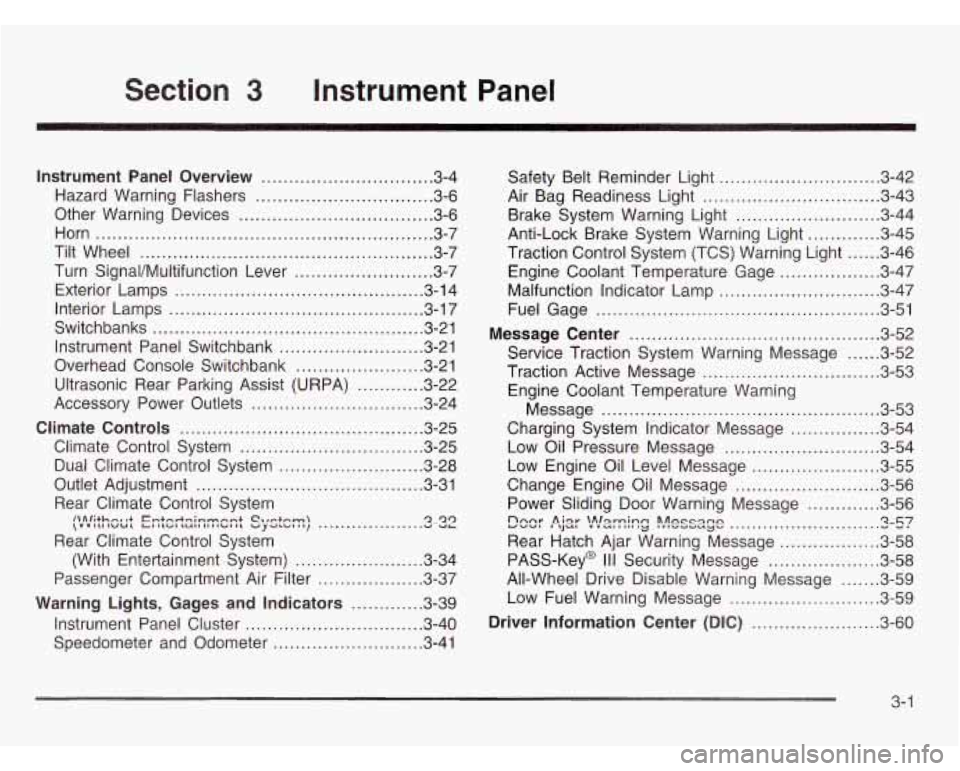
Section 3 Instrument Panel
Instrument Panel Overview ........................... 3.4
Hazard Warning Flashers
............................ 3.6
Other Warning Devices
............................... 3.6
Horn
............................................................. 3.7
Tilt Wheel
..................................................... 3-7
Turn SignaVMultifunction Lever
......................... 3.7
Exterior Lamps
............................................. 3.14
Interior Lamps
.............................................. 3.17
Switchbanks
................................................. 3.21
Instrument Panel Switchbank
.......................... 3-21
Overhead Console Switchbank
....................... 3.21
Ultrasonic Rear Parking Assist (URPA)
............ 3.22
Accessory Power Outlets
............................... 3.24
Climate Controls
............................................ 3.25
Climate Control System
................................. 3.25
Dual Climate Control System
.......................... 3.28
Rear Climate Control System
Rear Climate Control System (With Entertainment System)
...................... -3-34
Passenger Compartment Air Filter
................... 3.37
Warning Lights, Gages and Indicators
............. 3.39
Instrument Panel Cluster
................................ 3.40
Outlet Adjustment
......................................... 3.31
ilAlM-.nr I+ lZmtnwtq;n-mnt Ctrctnm \VUiLllWUL LIIL~ILUIIiIII~.. . Vy~L~..., .... ....... " "L 4-49
Speedometer and Odometer ........................... 3.41 Safety
Belt Reminder Light
............................. 3.42
Air Bag Readiness Light
................................ 3-43
Brake System Warning Light
.......................... 3-44
Anti-Lock Brake System Warning Light
............. 3-45
Traction Control System (TCS) Warning Light
...... 3-46
Engine Coolant Temperature Gage
.................. 3-47
Malfunction Indicator Lamp
............................. 3-47
Fuel Gage
................................................... 3-51
Message Center
............................................. 3-52
Service Traction System Warning Message
...... 3-52
Traction Active Message
................................ 3-53
Engine Coolant Temperature Warning
Message
.................................................. 3-53
Charging System Indicator Message
................ 3-54
Low Oil Pressure Message
............................ 3-54
Low Engine Oil Level Message
....................... 3-55
Change Engine Oil Message
.......................... 3-56
Power Sliding Door Warning Message
............. 3-56
Rear Hatch Ajar Warning Message
.................. 3-58
PASS-Key@
I II Security Message ................... -3-58
All-Wheel Drive Disable Warning Message
....... 3-59
Low Fuel Warning Message
........................... 3-59
Driver Information Center (DIC)
....................... 3-60
Eee: P, jar '!!s:n?!g !!esss;e .......................... ... Iz-c;7 v .
3- 1
Page 332 of 466
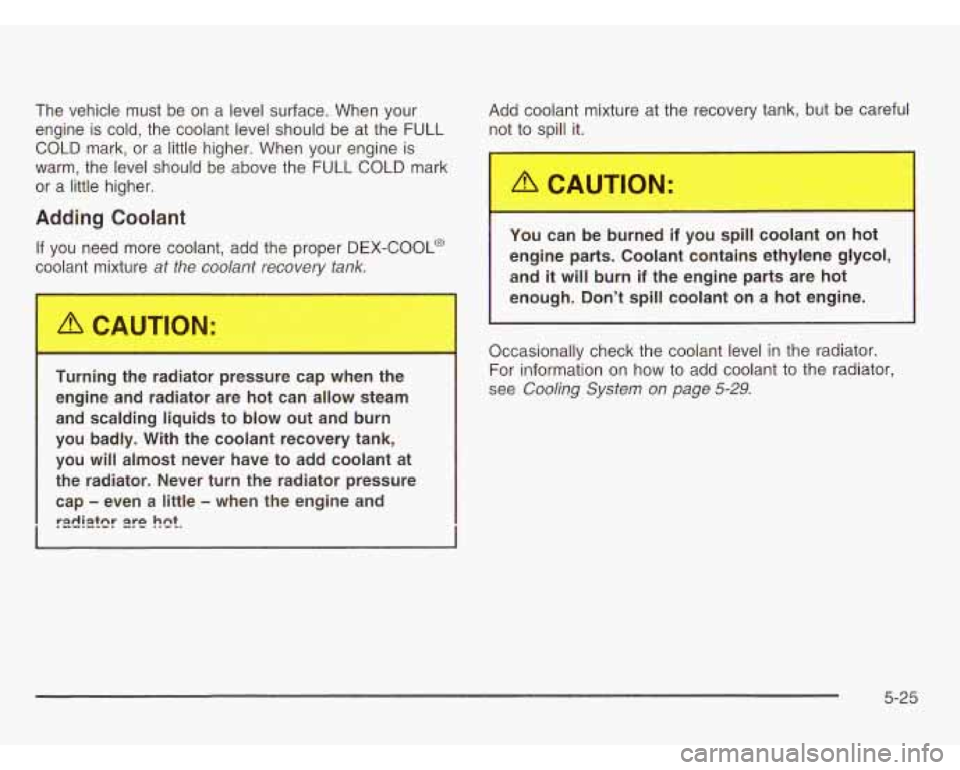
The vehicle must be on a level surface. When your
engine is cold, the coolant level should be at the FULL
COLD mark, or a little higher. When your engine is
warm, the level should be above the FULL COLD mark
or a little higher.
Adding Coolant
If you need more coolant, add the proper DEX-COOL@
coolant mixture at the coolant recovery tank.
Add coolant mixture at the recovery tank, but be careful
not to spill it.
Turning the radiator pressure cap when the engine and radiator are hot can allow steam
and scalding liquids to blow out and burn
you badly. With the coolant recovery tank,
you will almost never have to add coolant at
the radiator. Never turn the radiator pressure
cap
- even a little - when the engine and
radister Ere h3!.
You can be burned if you spill coolant on hot
engine parts. Coolant contains ethylene glycol,
and
it will burn if the engine parts are hot
enough. Don’t spill coolant on a
hot engine.
.
Occasionally check the coolant level in the radiator.
For information on how to add coolant to the radiator,
see
Cooling System on page 5-29.
5-25
Page 336 of 466
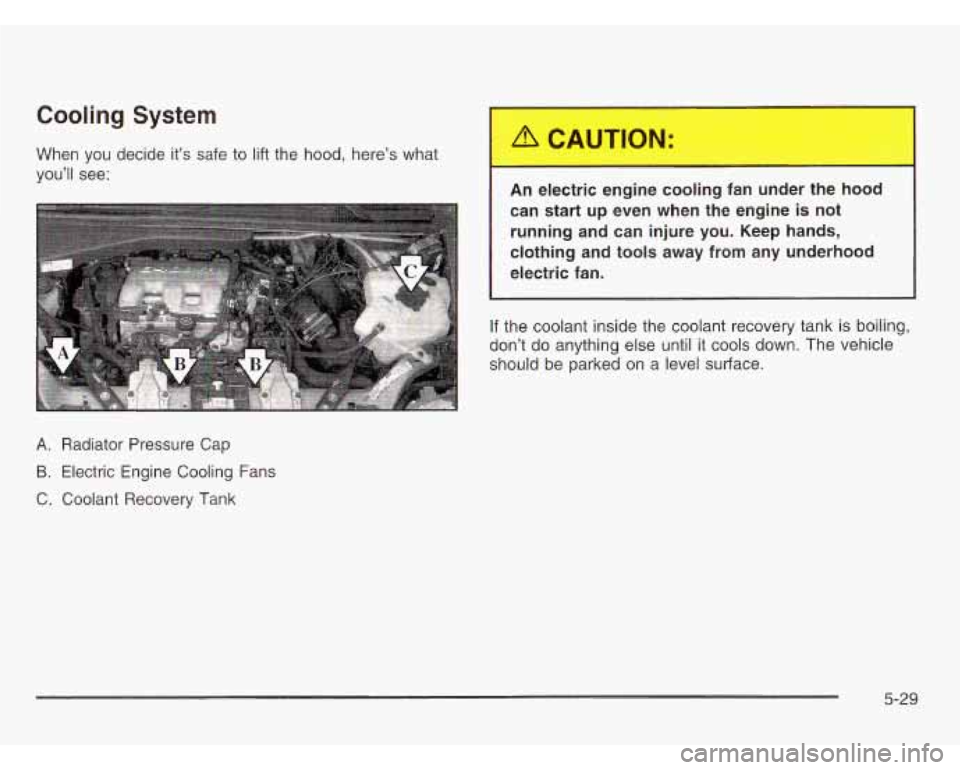
Cooling System
When you decide it’s safe to lift the hood, here’s what
you’ll see:
A. Radiator Pressure Cap
B. Electric Engine Cooling Fans
C. Coolant Recovery Tank An electric
engine cooling far. -..-er the hood
can start up even when the engine is not
running and can injure you. Keep hands,
clothing and tools away from any underhood
electric fan.
If the coolant inside the coolant recovery tank is boiling,
don’t do anything else until it cools down. The vehicle
should be parked on a level surface.
5-29
Page 337 of 466
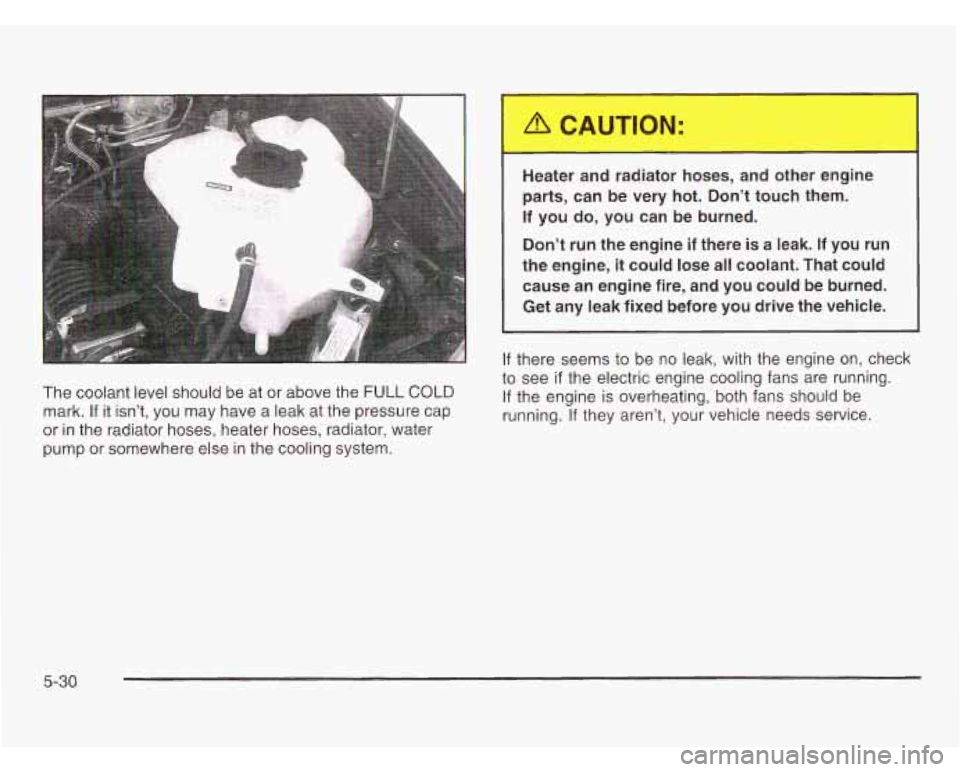
The coolant level should be at or above the FULL COLD
mark. If it isn’t, you may have a leak at the pressure cap
or in the radiator hoses, heater hoses, radiator, water
pump or somewhere else in the cooling system. Heater
and radiator hoses, and other engine
parts, can be very hot. Don’t touch them.
If you do, you can
be burned.
Don’t run the engine
if there is a leak. If you run
the engine,
it could lose all coolant. That could
cause an engine fire, and you could be burned.
Get any leak fixed before you drive the vehicle.
If there seems to be no leak, with the engine on, check
to see
if the electric engine cooling fans are running.
If the engine is overheating, both fans should be
running. If they aren’t, your vehicle needs service.
5-30
Page 338 of 466
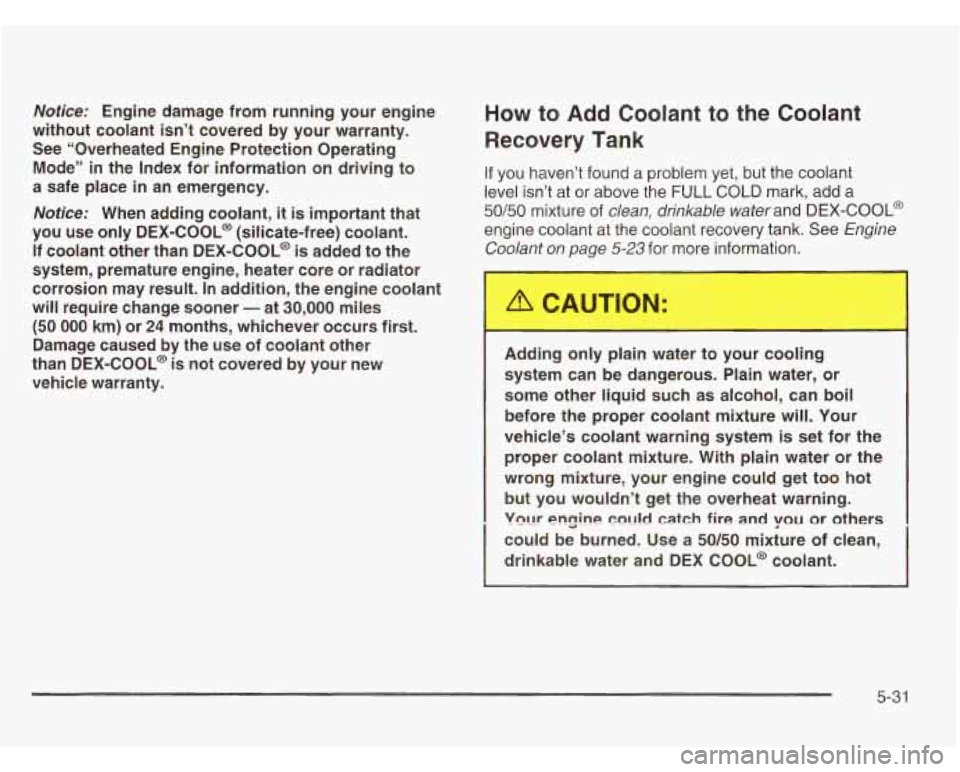
Notice: Engine damage from running your engine
without coolant isn’t covered by your warranty.
See “Overheated Engine Protection Operating
Mode” in the Index for information on driving to
a safe place in an emergency.
Notice: When adding coolant, it is important that
you use only
DEX-COOL@ (silicate-free) coolant.
If coolant other than DEX-COOL@
is added to the
system, premature engine, heater core or radiator
corrosion may result. In addition, the engine coolant
will require change sooner
- at 30,000 miles
(50 000 km) or 24 months, whichever occurs first.
Damage caused by the use of coolant other
than DEX-COOL@ is not covered by your new
vehicle warranty.
How to Add Coolant to the Coolant
Recovery Tank
If you haven’t found a problem yet, but the coolant
level isn’t at
or above the FULL COLD mark, add a
50/50 mixture of clean, drinkable waterand DEX-COOL@
engine coolant at the coolant recovery tank. See Engine
Coolant on page
5-23 for more information.
Adding only plain water to your cooling
system can be dangerous. Plain water, or
some other liquid such as alcohol, can boil
before the proper coolant mixture will. Your
vehicle’s coolant warning system
is set for the
proper coolant mixture. With plain water or the
wrong mixture, your engine could get too hot
but you wouldn’t get the overheat warning.
Vn~lr en~ine mt1ld catch fire and YOU or others
could be burned. Use a 50/50 mixture of clean,
drinkable water and DEX
COOL@ coolant.
5-31
Page 343 of 466
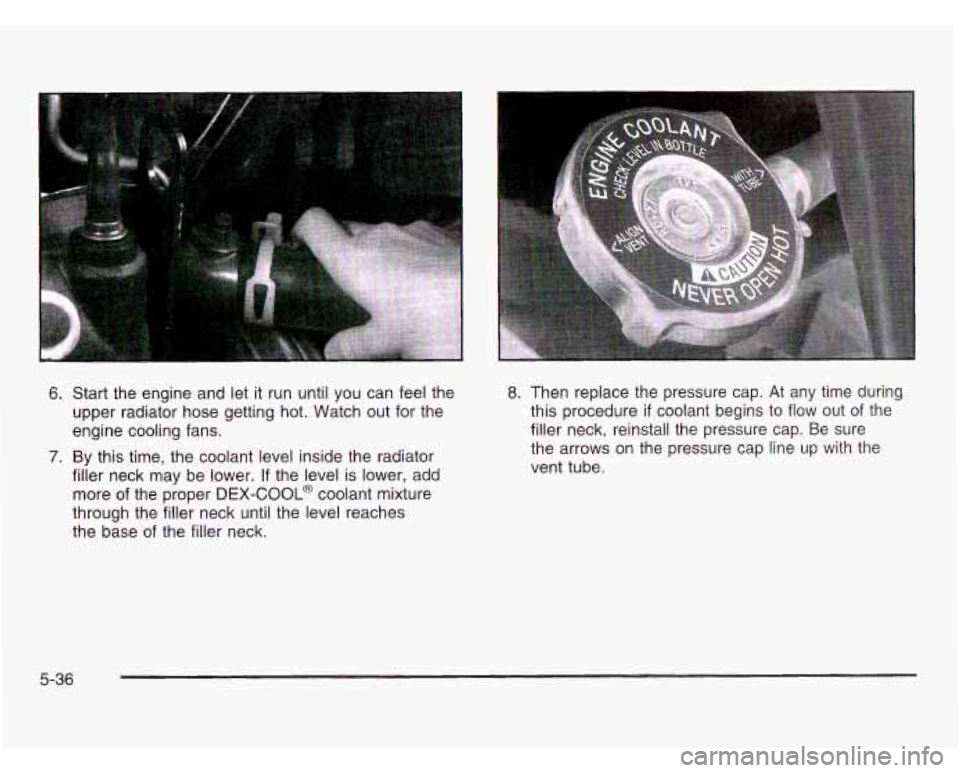
6.
7.
Start the engine and let it run until you can feel the
upper radiator hose getting hot. Watch out for the
engine cooling fans.
By this time, the coolant level inside the radiator
filler neck may be lower.
If the level is lower, add
more of the proper
DEX-COOL@ coolant mixture
through the filler neck until the level reaches
the base
of the filler neck. 8.
Then replace the pressure cap. At any time during
this procedure
if coolant begins to flow out of the
filler neck, reinstall the pressure cap. Be sure
the arrows on the pressure cap line up with the
vent tube.
5-36
Page 407 of 466
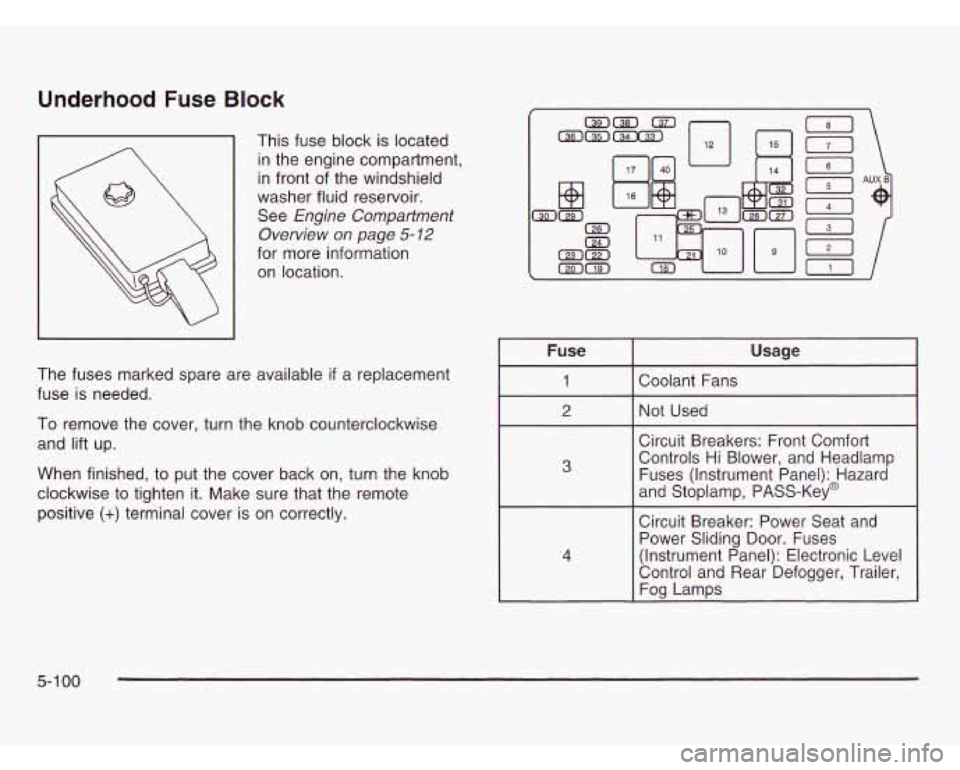
Underhood Fuse Block
This fuse block is located
in the engine compartment,
in front of the windshield
washer fluid reservoir.
See
Engine Compartment
Overview
on page 5-12
for more information
on location.
The fuses marked spare are available
if a replacement
fuse
is needed.
To remove the cover, turn the knob counterclockwise
and lift up.
When finished, to put the cover back on, turn the knob
clockwise to tighten it. Make sure that the remote
positive
(+) terminal cover is on correctly.
(71
[61
[2)
111 Aul
I Fuse
I 2
4
Usage
Coolant Fans
Not Used
Circuit Breakers: Front Comfort
Controls Hi Blower, and Headlamp
Fuses (Instrument Panel): Hazard
and Stoplamp, PASS-Key@
Circuit Breaker: Power Seat and
Power Sliding Door. Fuses
(Instrument Panel): Electronic Level
Control and Rear Defogger, Trailer,
Fog Lamps
5-1 00
Page 423 of 466
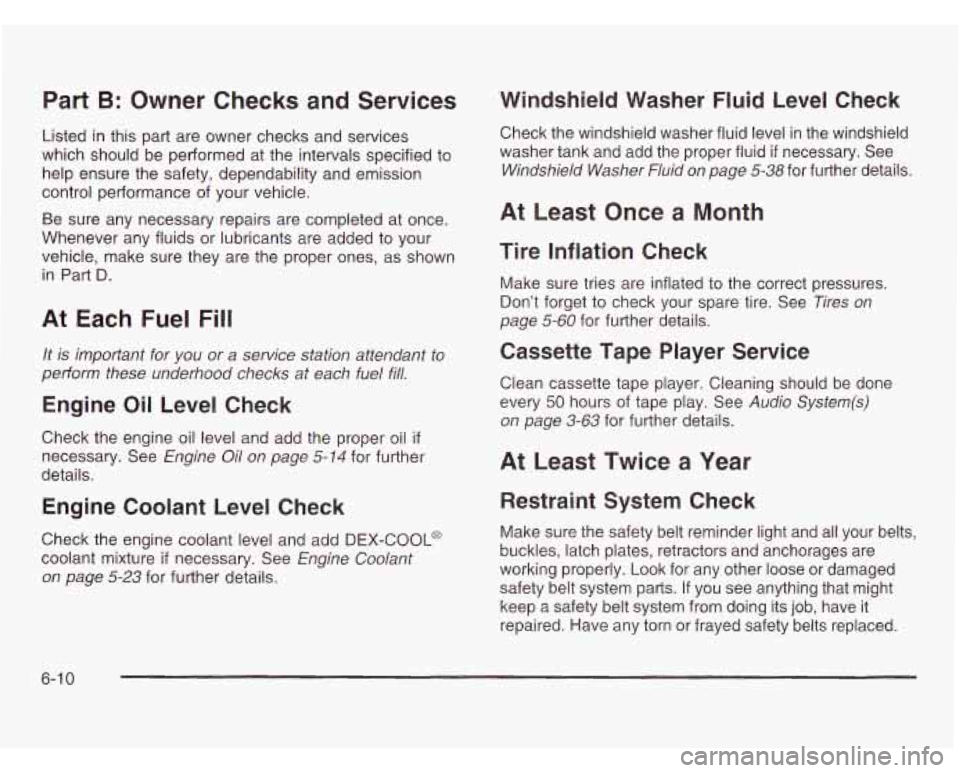
Part B: Owner Checks and Services
Listed in this part are owner checks and services
which should be performed at the intervals specified to
help ensure the safety, dependability and emission
control performance of your vehicle.
Be sure any necessary repairs are completed at once.
Whenever any fluids or lubricants are added to your
vehicle, make sure they are the proper ones, as shown
in Part D.
At Each Fuel Fill
It is important for you or a service station attendant to
perform these underhood checks at each fuel fill.
Engine Oil Level Check
Check the engine oil level and add the proper oil if
necessary. See Engine Oil on page 5-14 for further
details.
Engine Coolant Level Check
Check the engine coolant level and add DEX-COOL@
coolant mixture
if necessary. See Engine Coolant
on page 5-23
for further details.
Windshield Washer Fluid Level Check
Check the windshield washer fluid level in the windshield
washer tank and add the proper fluid
if necessary. See
Windshield Washer Fluid on page 5-38 for further details.
At Least Once a Month
Tire Inflation Check
Make sure tries are inflated to the correct pressures.
Don’t forget to check your spare tire. See
Tires on
page 5-60
for further details.
Cassette Tape Player Service
Clean cassette tape player. Cleaning should be done
every
50 hours of tape play. See Audio Systern(s)
on page 3-63 for further details.
At Least Twice a Year
Restraint System Check
:s , Make sure the safety belt reminder light and all your bell
buckles, latch plates, retractors and anchorages are
working properly. Look for any other loose or damaged
safety belt system parts.
If you see anything that might
keep a safety belt system from doing its
job, have it
repaired. Have any torn or frayed safety belts replaced.
6-1 0
Page 451 of 466

Engine (cont.)
Coolant Temperature Warning Message
.......... 3-53
Cooling System Inspection
............................ 6-1 4
Engine Compartment Overview
.... ........... 5-12
Exhaust
..................................................... 2-43
Low Oil Level Message
................................ 3-55
Oil
............................................................. 5-14
Overheating
................................................ 5-26
Starting
...................................................... 2-34
Engine Coolant Level Check
............................. 6-10
Engine Oil Additives
......................... ....... 5-17
Engine Oil and Chassis Lubrication Scheduled Maintenance
................................. 6-5
Engine Oil Level Check
................................... 6-10
Engine Specifications
..................................... 5-1 04
Entering Programming Mode
............................ 2-63
Entertainment System
...................................... 3-91
Cleaning the Video Screen
.......................... 3-105
Cleaning Your DVD Player
.......................... 3-105
DVD Distortion
.......................................... 3-103
Entry Lighting
................................................. 3-18
Erasing HomeLink@ Buttons
.............................. 2-52
Exit Lighting
................................................... 3-19
Exiting Programming Mode
............................... 2-71
Express-Down Window
.................................... 2-25
Extender, Safety Belt
....................................... 1-44
Exterior Lamps
............................................... 3-1 4
F
FabricKarpet ................................................. 5-87
Engine Air Cleaner
...................................... 5-19
Filter
Finding
a PTY Station
..................... 3.67. 3.74. 3-83
Finding a Station
............................ 3-65, 3-72, 3-81
Finish Care
.................................................... 5-91
Finish Damage
............................................... 5-92
Fixed Mast Antenna
....................................... 3-105
Flash-to-Pass
................................................... 3-9
Flat Tire
........................................................ 5-69
Flat Tire, Changing
......................................... 5-70
Flip and Fold Rear Seats
.................................. 1-7
Fluid Automatic Transaxle
..................................... 5-20
Power Steering
........................................... 5-37
Windshield Washer
...................................... 5-38
FM
.............................................................. 3-103
Fog Lamps
.................................................... 3-16
Folding or Reclining the Seatbacks
............. 1-8, 1-14
Folding the Seatback
....................................... 1-18
Following Distance
.......................................... 4-41
Footnotes
........................................................ 6-5
Front Reading Lamps
...... ........................ 3-19
Front Seat Storage Net
................................ 2-55
Fuel
............................................................... 5-5
Additives
................. .......................... 5-6
California Fuel
....................................... 5-6
Page 455 of 466

Maintenance Schedule (cont.) Exhaust System Inspection
........................... 6-1 4
Fuel System Inspection
................................ 6-14
How This Section is Organized ....................... 6-3
Introduction
.................................................. 6-2
Maintenance Requirements
............................. 6-2
Part A
- Scheduled Maintenance Services ......... 6-4
Part B
- Owner Checks and Services ............. 6-10
Part
C - Periodic Maintenance Inspections ...... 6-1 4
Part D
- Recommended Fluids and
Lubricants
............................................... 6-1 6
Part E . Maintenance Record ........................ 6-18
Scheduled Maintenance
................................. 6-5
Steering, Suspension and Front Drive Axle
Boot and Seal Inspection
.......................... 6-14
Throttle System Inspection
............................ 6-1 5
Transfer Case (Power Transfer Unit) and
Carrier Assembly-Differential (Rear Drive
Module) All-Wheel Drive Inspection
............. 6-1 5
Using Your ................................................... 6-4
Your Vehicle and the Environment
................... 6-2
Maintenance When Trailer Towing
..................... 4-43
Making Turns
................................................. 4-41
Malfunction Indicator Light
................................ 3-47
Manual Seats
................................................... 1-2 Matching
Transmitter(s) to Your Vehicle
................. 2-7
Message
Memory Seat
................................. ......... 2-72
All-Wheel Drive Disable Warning
....... ..... 3-59
Center
...................................... ......... 3-52
Change Engine Oil
...................................... 3-56
Charging System Indicator
............................ 3-54
Door Ajar Warning
....................................... 3-57
Engine Coolant Temperature Warning
............. 3-53
Low Engine Oil Level ................................... 3-55
Low Fuel Warning
................................... 3-59
Low Oil Pressure
.................... ............. 3-54
PASS-Key@
Ill Security ............................. 3-58
Power Sliding Door Warning
......................... 3-56
Rear Hatch Ajar Warning
.............................. 3-58
Service Traction System Warning
................... 3-52
Traction Active
............................................ 3-53
Manual Rearview Mirror
................................ 2-45
Outside Convex Mirror
................................. 2-46
Outside Heated Mirrors
................................ 2-46
Outside Power Mirrors
.................................. 2-45
Islands/Countries (Except Puerto Rico and
US
. Virgin Islands) ........................................ 7-4
Mirrors
Mexico, Central
America and Caribbean
10